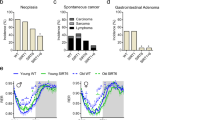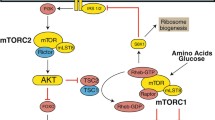Core Message
Our laboratory and others have been able to use the GHR−/− mice to elucidate the impacts of GH on aging. While many questions persist, these mice have helped to establish that a lack of GH action can extend life span in a manner similar to caloric restriction. Moreover, insulin sensitivity appears to be the most prominent mechanism shared between these two interventions that result in life span extension. Further analysis of the contribution of each of the insulin-sensitive tissues as they relate to GH should help focus on these mechanisms. Thus, our laboratory is currently generating liver, muscle, and adipose tissue-specific GHR gene disrupted mice. By investigating the dynamic interactions between GH and insulin signaling within these tissues, how they alter the physiology of other tissues in compensation for the lack of GHR, and the effect on aging will further our understanding of the GH-related mechanisms that extend longevity.
Access this chapter
Tax calculation will be finalised at checkout
Purchases are for personal use only
Similar content being viewed by others
References
Bartke A (2000) Delayed aging in Ames dwarf mice. Relationships to endocrine function and body size. Results Probl Cell Differ 29:181–202
Bartke A et al (2000) Growth hormone and aging. J Amer Aging Assoc 23:219–225
Bartke A, Wright JC, Mattison JA, Ingram DK, Miller RA, Roth GS (2001) Extending the lifespan of long-lived mice. Nature 414:412
Blackburn EH (2000) Telomeres and telomerase. Keio J Med 49:59–65
Bluher M, Kahn BB, Kahn CR (2003) Extended longevity in mice lacking the insulin receptor in adipose tissue. Science 299:572–574
Bonkowski MS, Rocha JS, Masternak MM, Al Regaiey KA, Bartke A (2006) Targeted disruption of growth hormone receptor interferes with the beneficial actions of calorie restriction. Proc Natl Acad Sci U S A 103:7901–7905
Bonkowski MS et al (2009) Disruption of growth hormone receptor prevents calorie restriction from improving insulin action and longevity. PLoS ONE 4:e4567
Breese CR, Ingram RL, Sonntag WE (1991) Influence of age and long-term dietary restriction on plasma insulin-like growth factor-1 (IGF-I), IGF-I gene expression, and IGF-I binding proteins. J Gerontol 46:B180–B187
Brownlee M (2001) Biochemistry and molecular cell biology of diabetic complications. Nature 414:813–820
Campisi J (1996) Replicative senescence: an old lives’ tale? Cell 84:497–500
Carter CS et al (2002) Models of growth hormone and IGF-I deficiency: applications to studies of aging processes and life-span determination. J Gerontol A Biol Sci Med Sci 57: B177–B188
Chen WY, Wight DC, Wagner TE, Kopchick JJ (1990) Expression of a mutated bovine growth hormone gene suppresses growth of transgenic mice. Proc Natl Acad Sci U S A 87:5061–5065
Chen WY, White ME, Wagner TE, Kopchick JJ (1991a) Functional antagonism between endogenous mouse growth hormone (GH) and a GH analog results in dwarf transgenic mice. Endocrinology 129:1402–1408
Chen WY, Wight DC, Mehta BV, Wagner TE, Kopchick JJ (1991b) Glycine 119 of bovine growth hormone is critical for growth-promoting activity. Mol Endocrinol 5:1845–1852
Clancy DJ et al (2001) Extension of life-span by loss of CHICO, a Drosophila insulin receptor substrate protein. Science 292: 104–106
Cooper MP, Machwe A, Orren DK, Brosh RM, Ramsden D, Bohr VA (2000) Ku complex interacts with and stimulates the Werner protein. Genes Dev 14:907–912
Cortopassi GA, Shibata D, Soong NW, Arnheim N (1992) A pattern of accumulation of a somatic deletion of mitochondrial DNA in aging human tissues. Proc Natl Acad Sci U S A 89:7370–7374
Coschigano KT, Clemmons D, Bellush LL, Kopchick JJ (2000) Assessment of growth parameters and life span of GHR/BP gene-disrupted mice. Endocrinology 141:2608–2613
Coschigano KT, Holland AN, Riders ME, List EO, Flyvbjerg A, Kopchick JJ (2003) Deletion, but not antagonism, of the mouse growth hormone receptor results in severely decreased body weights, insulin and IGF-I levels and increased lifespan. Endocrinology 144:3799–3810
Dominici FP, Hauck S, Argentino DP, Bartke A, Turyn D (2002) Increased insulin sensitivity and upregulation of insulin receptor, insulin receptor substrate (IRS)-1 and IRS-2 in liver of Ames dwarf mice. J Endocrinol 173:81–94
Dorman JB, Albinder B, Shroyer T, Kenyon C (1995) The age-1 and daf-2 genes function in a common pathway to control the lifespan of Caenorhabditis elegans. Genetics 141: 1399–1406
Dozmorov I, Galecki A, Chang Y, Krzesicki R, Vergara M, Miller RA (2002) Gene expression profile of long-lived snell dwarf mice. J Gerontol A Biol Sci Med Sci 57:B99–B108
Evans JL, Goldfine ID, Maddux BA, Grodsky GM (2002) Oxidative stress and stress-activated signaling pathways: a unifying hypothesis of type 2 diabetes. Endocr Rev 23: 599–622
Fabrizio P, Pozza F, Pletcher SD, Gendron CM, Longo VD (2001) Regulation of longevity and stress resistance by Sch9 in yeast. Science 292:288–290
Finkel T, Holbrook NJ (2000) Oxidants, oxidative stress and the biology of ageing. Nature 408:239–247
Flurkey K, Papaconstantinou J, Miller RA, Harrison DE (2001) Lifespan extension and delayed immune and collagen aging in mutant mice with defects in growth hormone production. Proc Natl Acad Sci U S A 98:6736–6741
Flurkey K, Papaconstantinou J, Harrison DE (2002) The Snell dwarf mutation Pit1(dw) can increase life span in mice. Mech Ageing Dev 123:121–130
Guarente L, Kenyon C (2000) Genetic pathways that regulate ageing in model organisms. Nature 408:255–262
Hasty P, Campisi J, Hoeijmakers J, van Steeg H, Vijg J (2003) Aging and genome maintenance: lessons from the mouse? Science 299:1355–1359
Holzenberger M et al (2003) IGF-I receptor regulates lifespan and resistance to oxidative stress in mice. Nature 421:182–187
Hsieh CC, DeFord JH, Flurkey K, Harrison DE, Papaconstantinou J (2002) Implications for the insulin signaling pathway in Snell dwarf mouse longevity: a similarity with the C. elegans longevity paradigm. Mech Ageing Dev 123:1229–1244
Johnson TE, Friedman DB, Fitzpatrick PA, Conley WL (1987) Mutant genes that extend life span. Basic Life Sci 42: 91–100
Kenyon C (2001) A conserved regulatory system for aging. Cell 105:165–168
Kenyon C, Chang J, Gensch E, Rudner A, Tabtiang R (1993) A C. elegans mutant that lives twice as long as wild type. Nature 366:461–464
Kimura KD, Tissenbaum HA, Liu Y, Ruvkun G (1997) daf-2, an insulin receptor-like gene that regulates longevity and diapause in Caenorhabditis elegans. Science 277:942–946
Kirkwood TB, Austad SN (2000) Why do we age? Nature 408:233–238
Koubova J, Guarente L (2003) How does calorie restriction work? Genes Dev 17:313–321
Kowald A (2002) Lifespan does not measure ageing. Biogerontology 3:187–190
Lin K, Dorman JB, Rodan A, Kenyon C (1997) daf-16: An HNF-3/forkhead family member that can function to double the life-span of Caenorhabditis elegans. Science 278:1319–1322
Longo VD, Finch CE (2003) Evolutionary medicine: from dwarf model systems to healthy centenarians? Science 299:1342–1346
Martin GM, Oshima J (2000) Lessons from human progeroid syndromes. Nature 408:263–266
Masoro EJ (2003) Subfield history: caloric restriction, slowing aging, and extending life. Sci Aging Knowledge Environ. 2003 Feb 26; 2003(8):RE2
Meites J (1990) Aging: hypothalamic catecholamines, neuroendocrine-immune interactions, and dietary restriction. Proc Soc Exp Biol Med 195:304–311
Migliaccio E et al (1999) The p66shc adaptor protein controls oxidative stress response and life span in mammals. Nature 402:309–313
Miller RA, Chang Y, Galecki AT, Al-Regaiey K, Kopchick JJ, Bartke A (2002) Gene expression patterns in calorically restricted mice: partial overlap with long-lived mutant mice. Mol Endocrinol 16:2657–2666
Nemoto S, Finkel T (2002) Redox regulation of forkhead proteins through a p66shc-dependent signaling pathway. Science 295:2450–2452
Nishikawa T, Edelstein D, Brownlee M (2000) The missing link: a single unifying mechanism for diabetic complications. Kidney Int Suppl 77:S26–S30
Ogg S et al (1997) The Fork head transcription factor DAF-16 transduces insulin-like metabolic and longevity signals in C. elegans. Nature 389:994–999
Okada S et al (1992) A growth hormone (GH) analog can antagonize the ability of native GH to promote differentiation of 3T3-F442A preadipocytes and stimulate insulin-like and lipolytic activities in primary rat adipocytes. Endocrinology 130:2284–2290
Parr T (1997) Insulin exposure and aging theory. Gerontology 43:182–200
Parr T (1999) Insulin exposure and unifying aging. Gerontology 45:121–135
Quigley K, Goya R, Nachreiner R, Meites J (1990) Effects of underfeeding and refeeding on GH and thyroid hormone secretion in young, middle-aged, and old rats. Exp Gerontol 25:447–457
Sell DR et al (2003) The effect of caloric restriction on glycation and glycoxidation in skin collagen of nonhuman primates. J Gerontol A Biol Sci Med Sci 58:508–516
Singh R, Barden A, Mori T, Beilin L (2001) Advanced glycation end-products: a review. Diabetologia 44:129–146
Sohal RS, Weindruch R (1996) Oxidative stress, caloric restriction, and aging. Science 273:59–63
Tanhauser SM, Laipis PJ (1995) Multiple deletions are detectable in mitochondrial DNA of aging mice. J Biol Chem 270:24769–24775
Tatar M, Kopelman A, Epstein D, Tu MP, Yin CM, Garofalo RS (2001) A mutant Drosophila insulin receptor homolog that extends life-span and impairs neuroendocrine function. Science 292:107–110
Tatar M, Bartke A, Antebi A (2003) The endocrine regulation of aging by insulin-like signals. Science 299:1346–1351
Teillet L et al (2000) Food restriction prevents advanced glycation end product accumulation and retards kidney aging in lean rats. J Am Soc Nephrol 11:1488–1497
Van Remmen H, Richardson A (2001) Oxidative damage to mitochondria and aging. Exp Gerontol 36:957–968
Vogel H, Lim DS, Karsenty G, Finegold M, Hasty P (1999) Deletion of Ku86 causes early onset of senescence in mice. Proc Natl Acad Sci U S A 96:10770–10775
Wolf E, Kahnt E, Ehrlein J, Hermanns W, Brem G, Wanke R (1993) Effects of long-term elevated serum levels of growth hormone on life expectancy of mice: lessons from transgenic animal models. Mech Ageing Dev 68:71–87
Xu BC et al (1995) Effects of growth hormone antagonists on 3T3-F442A preadipocyte differentiation. J Endocrinol 146:131–139
Yu CE et al (1996) Positional cloning of the Werner’s syndrome gene. Science 272:258–262
Zhou Y, He L, Baumann G, Kopchick JJ (1997a) Deletion of the mouse GH-binding protein (mGHBP) mRNA polyadenylation and splicing sites does not abolish production of mGHBP. J Mol Endocrinol 19:1–13
Zhou Y et al (1997b) A mammalian model for Laron syndrome produced by targeted disruption of the mouse growth hormone receptor/binding protein gene (the Laron mouse). Proc Natl Acad Sci U S A 94:13215–13220
Author information
Authors and Affiliations
Corresponding author
Editor information
Editors and Affiliations
Rights and permissions
Copyright information
© 2011 Springer Berlin Heidelberg
About this chapter
Cite this chapter
List, E.O. (2011). Role of GH/IGF-I Deficiency in Aging. In: Laron, Z., Kopchick, J. (eds) Laron Syndrome - From Man to Mouse. Springer, Berlin, Heidelberg. https://doi.org/10.1007/978-3-642-11183-9_50
Download citation
DOI: https://doi.org/10.1007/978-3-642-11183-9_50
Published:
Publisher Name: Springer, Berlin, Heidelberg
Print ISBN: 978-3-642-11182-2
Online ISBN: 978-3-642-11183-9
eBook Packages: MedicineMedicine (R0)




